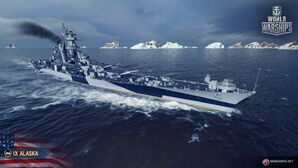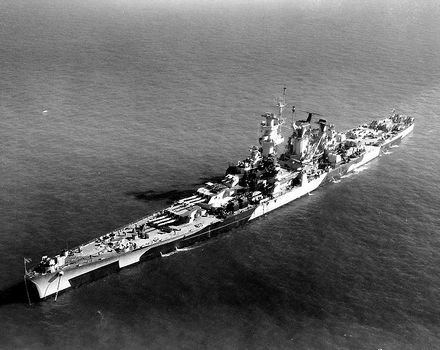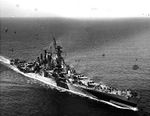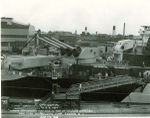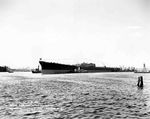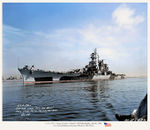Alaska
| Revision as of 07:24, 24 February 2019 Added service history. | Revision as of 21:26, 24 February 2019 Overall polish. | |||
| Line 9: | Line 9: | |||
| |Performance=<!-- write text about performance in battles below --> | |Performance=<!-- write text about performance in battles below --> | |||
| ? | ''{{#var:ship_name}}'' is the second Tier IX | + | USS ''{{#var:ship_name}}'' is the second Tier IX ship available for Free Experience ({{FXP}}) in the American tech tree, and is the first Free XP ship to be priced at 1,000,000{{FXP}}. | |
| ? | On paper, many aspects of ''{{#var:ship_name}}'' will resemble those of her | + | On paper, many aspects of ''{{#var:ship_name}}'' will resemble those of her counterparts, ''[[Kronshtadt]]'' and ''[[Azuma]]''. In game, however, captains will find that ''{{#var:ship_name}}'' has a play style more similar to that of German heavy cruisers (such as ''[[Roon]]''). Armed with nine 305mm guns, she lacks the ability to go "AP only" in battle; something that her Russian counterpart can do quite easily. Captains are highly encouraged to invest in the Expert Loader skill in order to make the most of her main battery. In this respect, ''{{#var:ship_name}}'' is quite similar to normal cruisers in that she will regularly change shell types depending on the chosen target. | |
| ? | As far as her armor goes, she keeps the trend of high-tier | + | As far as her armor goes, she keeps the trend of high-tier American cruisers having 27mm plating at their extremities, as well as possessing an overmatch-proof middle deck. Compared to ''Kronshtadt'', ''{{#var:ship_name}}'' is better armored and has a lower detection, resulting in a similar "survivability" to that of ''Kronshtadt'' (despite having over 10,000 fewer hit points). ''{{#var:ship_name}}'' also has a below-the-waterline citadel, allowing her frequently avoid citadel hits at close range. Still, her side armor is still quite weak, and when taking battleship-caliber fire at range, her citadel remains highly vulnerable. Captains should keep an eye on enemy battleship positions, and either angle or make use of concealment accordingly. | |
| ? | + | |||
| ? | + | |||
| + | Much of ''{{#var:ship_name}}''’s playstyle is based on choosing fights wisely. Although she has great armor — for a cruiser — and solid guns, she will still be out damaged by equal and higher tier cruisers due to her slower rate-of-fire, and her armor loses much of its strength when facing off against high-tier battleships. Captains should avoid thinking that her large guns and good armor can allow her to carry an engagement. Early game for ''{{#var:ship_name}}'' is much the same as it is for any other cruiser, while in the late game a healthy ''{{#var:ship_name}}'' can make the difference between a loss and a win. Learning when ''{{#var:ship_name}}'' can safely engage targets in one-on-one duels and win is an important skill for captains looking to maximize her game play. | |||
| |Pros=<!-- write list of positive points below. use * as in ordinary wiki-list. --> | |Pros=<!-- write list of positive points below. use * as in ordinary wiki-list. --> | |||
| * Large 305mm main battery armament. | * Large 305mm main battery armament. | |||
| ? | * ''{{#var:ship_name}}'' | + | * ''{{#var:ship_name}}''’s large health pool, good concealment, and sturdy armor allow her freedom in positioning and the ability to withstand fire from equivalent tier cruisers. | |
| * Strong AA suite can protect her from most enemy aircraft. | * Strong AA suite can protect her from most enemy aircraft. | |||
| * Excellent accuracy on her main battery armament aids in her role of a cruiser killer. | * Excellent accuracy on her main battery armament aids in her role of a cruiser killer. | |||
| ? | * Has access to {{Surveillance Radar}} | + | * Has access to {{Surveillance Radar}}. | |
| |Cons=<!-- write list of negative points below. use * as in ordinary wiki-list. --> | |Cons=<!-- write list of negative points below. use * as in ordinary wiki-list. --> | |||
| * Increased [[Ship:Fire|fire]] duration (60 seconds) and vulnerability to multiple fires when under HE spam compared to other cruisers. | * Increased [[Ship:Fire|fire]] duration (60 seconds) and vulnerability to multiple fires when under HE spam compared to other cruisers. | |||
| * Large size and more sluggish maneuverability makes her an easier target for both enemy shells and torpedoes. | * Large size and more sluggish maneuverability makes her an easier target for both enemy shells and torpedoes. | |||
| + | * Her large size also makes her an easy target to hit, even when actively maneuvering. | |||
| * Armor is not thick enough to let her tank battleship fire and HE spam in open combat. | * Armor is not thick enough to let her tank battleship fire and HE spam in open combat. | |||
| Line 47: | Line 47: | |||
| '''Upgrade Slot 1''' provides players with two viable choices. {{Main Armaments Modification 1}} is generally recommended; however, for anti-aircraft duties, players should take {{Auxiliary Armaments Modification 1}}. | '''Upgrade Slot 1''' provides players with two viable choices. {{Main Armaments Modification 1}} is generally recommended; however, for anti-aircraft duties, players should take {{Auxiliary Armaments Modification 1}}. | |||
| ? | '''Upgrade Slot 2''' allows players to extend the duration of the | + | '''Upgrade Slot 2''' allows players to extend the duration of the {{Surveillance Radar}} consumable if they have the appropriate upgrade available in the [[Ship:Armory|Armory]]. Otherwise, {{Damage Control System Modification 1}} is recommended. | |
| ? | '''Upgrade Slot 4''' provides | + | '''Upgrade Slot 4''' provides several viable options. For increased survivability, {{Damage Control System Modification 2}} is a good choice. Many players utilize {{Steering Gears Modification 2}} to increase the maneuverability of the ship, while others will opt for {{Propulsion Modification 2}} in order to get ''{{#var:ship_name}}'' moving quickly when stationary. Choosing between these upgrades will be determined by the intended play style. | |
| + | ||||
| + | The default pick for many players in '''Upgrade Slot 5''' will be {{Concealment System Modification 1}}, but as a cruiser, ''{{#var:ship_name}}'' also has access to {{Steering Gears Modification 3}}. When stacked with {{Steering Gears Modification 2}} in '''Upgrade Slot 4''', ''{{#var:ship_name}}'' becomes highly maneuverable and can sometimes juke and dodge incoming fire at longer ranges. This is a valuable ability to have in the early stages of a match, and captains who feel comfortable eschewing a maximum stealth build are encouraged to try it out. | |||
| Line 59: | Line 61: | |||
| | Preventative Maintenance = 1 | | Preventative Maintenance = 1 | |||
| | Expert Loader = 2 | | Expert Loader = 2 | |||
| ? | | | + | | Air Supremacy = | |
| ? | | Direction Center for | + | | Direction Center for Fighters = 1 | |
| ? | | | + | | Improved Engine Boost = | |
| | Incoming Fire Alert = 1 | | Incoming Fire Alert = 1 | |||
| | Evasive Maneuver = | | Evasive Maneuver = | |||
| Line 70: | Line 72: | |||
| | Torpedo Acceleration = | | Torpedo Acceleration = | |||
| | Smoke Screen Expert = | | Smoke Screen Expert = | |||
| ? | | | + | | Improved Engines = | |
| | Adrenaline Rush = 3 | | Adrenaline Rush = 3 | |||
| | Last Stand = | | Last Stand = | |||
| Line 77: | Line 79: | |||
| | Survivability Expert = | | Survivability Expert = | |||
| | Torpedo Armament Expertise = | | Torpedo Armament Expertise = | |||
| ? | | | + | | Aircraft Armor = | |
| | Basic Firing Training = 2 | | Basic Firing Training = 2 | |||
| | Superintendent = 3 | | Superintendent = 3 | |||
| Line 86: | Line 88: | |||
| | Fire Prevention = 2 | | Fire Prevention = 2 | |||
| | Inertia Fuse for HE Shells = | | Inertia Fuse for HE Shells = | |||
| ? | | | + | | Sight Stabilization = | |
| | Advanced Firing Training = 2 | | Advanced Firing Training = 2 | |||
| | Manual Fire Control for AA Armament = 2 | | Manual Fire Control for AA Armament = 2 | |||
| Line 199: | Line 201: | |||
| ===Design=== | ===Design=== | |||
| ? | The ''Alaska''-class of large cruisers could be seen as an extension of the creative exercises undertaken by many navies during the treaty-era of ship construction in order to work around the imposed limitations. The impetus behind this specific class of cruisers were to counter the deployment of Germany’s ''[[Admiral Graf Spee|Deutschland]]''-class | + | The ''Alaska''-class of large cruisers could be seen as an extension of the creative exercises undertaken by many navies during the treaty-era of ship construction in order to work around the imposed limitations. The impetus behind this specific class of cruisers were to counter the deployment of Germany’s ''[[Admiral Graf Spee|Deutschland]]''-class ''panzerschiffes'' and Japan’s [[Azuma|Design B-65]] cruisers under consideration in the late 1930s: ships that were designed to counter heavy cruisers. Subsequently, in 1938 the General Board of the Navy directed the Bureau of Construction and Repair to initiate studies into designing a ship with the directive to counter these “super cruisers”. | |
| ? | Although superficially resembling the doctrine behind the implementation of battlecruisers in European navies in the early 20th century, the US Navy officially considered this group of surface ships | + | Although superficially resembling the doctrine behind the implementation of battlecruisers in European navies in the early 20th century, the US Navy officially considered this group of surface ships to be quite different. In their eyes, the battlecruisers of old were considered complementary capital ships to battleships; trading armor for speed in order to chase down combatants that the battleships couldn’t catch. These “large cruisers” were seen as up-scaled heavy cruisers; this doctrine showed its influence in the design process. Officially, the class used a unique designation — “CB” — to reflect their status. Furthermore, the proposed ships were named after US territories, reflecting their intermediate nature between cruisers and capital ships. | |
| ? | Due to the inexperience of never having previously designed a “large cruiser”, the entire process was wrought with uncertainty. One of the initial design targets | + | Due to the inexperience of never having previously designed a “large cruiser”, the entire process was wrought with uncertainty. One of the initial design targets considered was a standard displacement of 25,000 tons; a position between heavy cruisers and battleships. To expedite the process, a plethora of design cues were taken from heavy cruisers. The main armament arrangement was identical, plus the secondary and anti-aircraft suite was very similar to the ''[[Baltimore]]''-class of cruisers (despite having a much larger hull). Akin to the ''[[New Orleans]]''-class cruisers, the aviation facilities were placed in the center of the ship (as opposed to the stern, like on newer-generation heavy cruisers and battleships). Amusingly - like heavy cruisers - only a single large rudder was considered, which resulted in a poor turning circle bested by battleships and fleet carriers. | |
| ? | Other shortcuts adopted included replicating the propulsion machinery of the ''Essex''-class carriers | + | Other shortcuts were adopted, included replicating the propulsion machinery of the ''Essex''-class carriers, since they were of similar displacement to the ''Alaska''-class. The combination of 8 boilers and 4 turbines generated 150,000 shaft horsepower and propelled the ships to over 31 knots. The only design similarity to battleships would be the implementation of a columnar tower-style superstructure in order to place fire-control systems high enough to take advantage of the longer ranges attainable by the main armament. | |
| ? | The ''Alaska''-class | + | The ''Alaska''-class equipped nine 12-inch, 50 caliber Mark 8 rifles as the main armament, similar to the “cruiser killers” being implemented by the Axis navies. Designed solely for the ''Alaska''-class, they took advantage of ballistic technology being implemented in the early 1940s. For instance, the implementation of a multistage powder hoist allowed for each rifle to hurl a 500kg shell upto 35,000m every twenty to twenty-four seconds. In accordance with the belief that the ''Alaska''-class would be trading gunfire with other cruisers, the armor scheme centered around a nine-inch (228mm) armored belt that would ensure protection against shells up to 11” (279mm) in caliber. But in order to save tonnage, the decision was made to not equip the class with any underwater protection systems; instead, this luxury was reserved for carriers and battleships. This would render the class highly vulnerable to torpedoes, mines, and any short-falling shells. Truly, they were cruisers in the guise of battleships. | |
| ? | + | The design of the class was finalized in September 1940, and six were ordered as part of the naval expansion programs undertaken by the US Navy prior to their entry into World War II. USS ''Alaska'' (CB-1), named after the then-Territory of Alaska, was laid down ten days after the Japanese attack on Pearl Harbor at Camden, New Jersey by the New York Shipbuilding Corporation. She was launched 15 August 1943 and was formally commissioned into the US Navy on 17 June 1944. | ||
| ===Service=== | ===Service=== | |||
| ? | + | USS ''Alaska'' (CB-1) was the first of only two completed "large cruisers" designed primarily to counter Japanese heavy cruisers. Unfortunately, ''Alaska'' did not make it to the eastern Pacific in time to take part in the Battle of Leyte Gulf, the last large-scale sortie the Imperial Japanese Navy could muster. After commissioning, she sailed to the Caribbean for a shakedown cruise, trials, and exercises for the rest of 1944. | ||
| ? | + | |||
| ? | + | |||
| ? | + | On 8 January 1945, ''Alaska'' departed California for Hawaii, reaching Pearl Harbor on the 13th. She joined Task Group 58.5, a part of the screening force for Task Force 58, the well-known Fast Carrier Task Force. ''Alaska'' was tasked with screening USS ''[[Enterprise]]'' (CV-6) and USS ''Saratoga'' (CV-3) as the fleet departed for Japan. Following air strikes on Tokyo on 10 February, ''Alaska'' was transferred to Task Group 58.4 and assigned to support the assault on Iwo Jima. She screened carriers off Iwo Jima for 19 days, then returning to Ulithi to replenish. Remaining with Task Group 58.4, her next mission was the Battle of Okinawa, where she was to screen USS ''Yorktown'' (CV-10) and USS ''Intrepid'' (CV-11). It was here that ''Alaska'' had her first taste of real combat; the Japanese launched a major retaliatory airstrike on the Allied fleet; ''Alaska'' was credited with shooting down two Japanese bombers, one as it attempted to crash into ''Intrepid''. The next day, USS ''Franklin'' (CV-13) was crippled by bomb hits and a devastatingly successful kamikaze strike. ''Alaska'' — alongside her sister USS ''Guam'' (CB-2) and in conjunction with two other cruisers and several destroyers — detached to form Task Group 58.2.9 to escort ''Franklin'' back to the safety of Ulithi, after repairs were undertaken to ensure ''Franklin'' could make the journey. En route to Ulithi, ''Franklin'' again came under attack from another bomber, and her escorts failed to shoot it down. Gunfire from one of ''Alaska''’s 5”/39 Mk 28 Mod 2s guns caused flash burns on nearby sailors, but none died. These constituted the only causalities suffered by ''Alaska'' during the war. ''Alaska'' took lead of the fleet escorting ''Franklin'', and the following day, her air search radar helped Allied fighters intercept and destroy a Japanese heavy fighter. ''Alaska'' and her task force reached Ulithi on 22 March, and she detached to rejoin TG 58.4. | ||
| ? | + | Returning to Okinawa,''Alaska'' continued to screen for the aircraft carriers participating in the subjugation of the island. On 27 March she carried out her first bombardment on the island of Minamidaitou in southern Okinawa. After refueling, she returned to Okinawa to support the landings when they began on 1 April. Throughout April, ''Alaska'' claimed several confirmed aircraft kills and several more assists. She arrived back in Ulithi on 14 May to resupply, where she then joined Task Group 38.4, bound again for Okinawa, where ''Alaska'' resumed her anti-aircraft defense role. ''Alaska'' and ''Guam'' bombarded the southern Okinawan island of Oki Daitou, before the fleet steamed for Leyte Gulf for rest and maintenance until mid-July. ''Alaska'' then was assigned to Cruiser Task Group 95 alongside ''Guam'', and she steamed for the East China and Yellow Seas to sink Japanese shipping vessels. Her last major wartime service was a raid into the estuary of the Yangtze River off Shanghai to strike Japanese airfields. Both these were met with limited success. ''Alaska'' returned to Okinawa, where she remained until the end of the war. | ||
| + | On 30 August 1945, ''Alaska'' departed Okinawa for Japan as part of the Seventh Fleet occupation forces. She sailed from Incheon, Korea, to Tsingtao, China, where she supported the 6th Marine Division in their occupation of the area until mid-November; she then returned to Incheon to embark soldiers as part of Operation Magic Carpet. After disembarking soldiers at San Francisco, she left for the Atlantic, returning to the Boston Navy Yard on 18 December 1945. She left Boston on 1 February 1946 for Bayonne, New Jersey, where she would be berthed in reserve. While she was removed from active service on the 13 August 1946, she was not decommissioned until mid-February 1947. There she remained largely forgotten for over a decade, until in 1958 the Bureau of Ships did two feasibility studies to see if ''Alaska'' and ''Guam'' were suitable for conversion to guided missile cruisers. The conversion process was deemed too expensive, and the proposal was abandoned. Both ships were stricken on 1 June 1960, and sold for scrap to on the 30th. ''Alaska'' was awarded four medals, including the Asiatic-Pacific Campaign Medal with three battle stars. | |||
| |HistoricalGallery=<!-- write below list of files with description (if necessary) separated with | --><gallery> | |HistoricalGallery=<!-- write below list of files with description (if necessary) separated with | --><gallery> | |||
| ? | File:USS Alaska (CB-1) underway on 11 September 1944 (NH 97127).jpg|''Alaska'' underway. | + | File:USS Alaska (CB-1) underway on 11 September 1944 (NH 97127).jpg|USS ''Alaska'' (CB-1) underway. | |
| ? | File:Alaska fore turrets.jpg|A close-up of '' | + | File:Alaska fore turrets.jpg|A close-up of ''Alaska''’s forward main gun turrets. | |
| File:Alaska at anchor.jpg | File:Alaska at anchor.jpg | |||
| ? | File:Alaska launch.jpg|A view on '' | + | File:Alaska launch.jpg|A view on ''Alaska''’s hull shortly after her hull was launched. | |
| File:Alaska colorized.jpg | File:Alaska colorized.jpg | |||
| ? | File:Alaska moored post war.jpg|'' | + | File:Alaska moored post war.jpg|''Alaska'' shortly after the war. | |
| </gallery> | </gallery> | |||
Revision as of 21:26, 24 February 2019
| 305 mm/50 Mk.8 in a turret3 х 3 pcs. |
| Rate of Fire3 shots/min. |
| Reload Time20 sec. |
| Rotation Speed6 deg./sec. |
| 180 Degree Turn Time30 sec. |
| Firing Range18.97 km. |
| Maximum Dispersion207 m. |
| HE Shell305 mm HE Mk17 mod. 1 |
| Maximum HE Shell Damage4,300 |
| Chance of Fire on Target Caused by HE Shell27 % |
| Initial HE Shell Velocity808 m./s. |
| HE Shell Weight462.3 kg. |
| AP Shell305 mm AP Mk18 mod. 1 |
| Maximum AP Shell Damage8,900 |
| Initial AP Shell Velocity762 m./s. |
| AP Shell Weight517 kg. |
| 127 mm/38 Mk.12 on a Mk.32 mount6 х 2 pcs. |
| Firing Range6.95 km. |
| Rate of Fire10 shots/min. |
| Reload Time6 sec. |
| HE Shell127 mm HE Mk32 |
| Maximum HE Shell Damage1,800 |
| Initial HE Shell Velocity792 m./s. |
| Chance of Fire on Target Caused by HE Shell5 % |
| 127 mm/38 Mk.12 on a Mk.32 mount6 х 2 pcs. |
| . . . Average Damage per Second90.6 |
| . . . Firing Range5.01 km. |
| 40 mm/56 Bofors on a Mk.2 mount14 х 4 pcs. |
| . . . Average Damage per Second222.6 |
| . . . Firing Range3.51 km. |
| 20 mm Oerlikon on a Mk.4 mount34 х 1 pcs. |
| . . . Average Damage per Second122.4 |
| . . . Firing Range2.01 km. |
| Maximum Speed33 knot |
| Turning Circle Radius850 m. |
| Rudder Shift Time13 sec. |
| Surface Detectability Range15.04 km. |
| Air Detectability Range9.72 km. |
Alaska — American special premium Tier IX cruiser.
An instance of a special type of ship, somewhere between a cruiser and a battleship. Officially classified as a "large cruiser", she was armed with 305 mm guns, had a high speed, and powerful AA defenses. On the other hand, she had relatively weak protection for her size.
Modules
 |
Hit Points (HP) | Armor (mm) | Armor (mm) | Main Turrets (pcs.) | Secondary Gun Turrets (pcs.) | AA Mounts (pcs.) | Torpedo Tubes (pcs.) | Hangar Capacity (pcs.) |
Research price (exp) |
Purchase price ( | |
|---|---|---|---|---|---|---|---|---|---|---|---|
| Alaska | 60,800 | 16 | 325 | 3 | 6 | 34/14/6 | 0 | 0 |
Compatible Upgrades
| Slot 1 |
|||||
|---|---|---|---|---|---|
| Slot 2 |
|||||
| Slot 3 |
|||||
| Slot 4 |
|||||
| Slot 5 |
|||||
| Slot 6 |
Player Opinion
Performance
USS Alaska is the second Tier IX ship available for Free Experience (![]() ) in the American tech tree, and is the first Free XP ship to be priced at 1,000,000
) in the American tech tree, and is the first Free XP ship to be priced at 1,000,000![]() .
.
On paper, many aspects of Alaska will resemble those of her counterparts, Kronshtadt and Azuma. In game, however, captains will find that Alaska has a play style more similar to that of German heavy cruisers (such as Roon). Armed with nine 305mm guns, she lacks the ability to go "AP only" in battle; something that her Russian counterpart can do quite easily. Captains are highly encouraged to invest in the Expert Loader skill in order to make the most of her main battery. In this respect, Alaska is quite similar to normal cruisers in that she will regularly change shell types depending on the chosen target.
As far as her armor goes, she keeps the trend of high-tier American cruisers having 27mm plating at their extremities, as well as possessing an overmatch-proof middle deck. Compared to Kronshtadt, Alaska is better armored and has a lower detection, resulting in a similar "survivability" to that of Kronshtadt (despite having over 10,000 fewer hit points). Alaska also has a below-the-waterline citadel, allowing her frequently avoid citadel hits at close range. Still, her side armor is still quite weak, and when taking battleship-caliber fire at range, her citadel remains highly vulnerable. Captains should keep an eye on enemy battleship positions, and either angle or make use of concealment accordingly.
Much of Alaska’s playstyle is based on choosing fights wisely. Although she has great armor — for a cruiser — and solid guns, she will still be out damaged by equal and higher tier cruisers due to her slower rate-of-fire, and her armor loses much of its strength when facing off against high-tier battleships. Captains should avoid thinking that her large guns and good armor can allow her to carry an engagement. Early game for Alaska is much the same as it is for any other cruiser, while in the late game a healthy Alaska can make the difference between a loss and a win. Learning when Alaska can safely engage targets in one-on-one duels and win is an important skill for captains looking to maximize her game play.Pros:
- Large 305mm main battery armament.
- Alaska’s large health pool, good concealment, and sturdy armor allow her freedom in positioning and the ability to withstand fire from equivalent tier cruisers.
- Strong AA suite can protect her from most enemy aircraft.
- Excellent accuracy on her main battery armament aids in her role of a cruiser killer.
- Has access to Surveillance Radar
 .
.
Cons:
- Increased fire duration (60 seconds) and vulnerability to multiple fires when under HE spam compared to other cruisers.
- Large size and more sluggish maneuverability makes her an easier target for both enemy shells and torpedoes.
- Her large size also makes her an easy target to hit, even when actively maneuvering.
- Armor is not thick enough to let her tank battleship fire and HE spam in open combat.
Research
Optimal Configuration
Upgrades
The recommended upgrades for Alaska are as follows:
- Slot 1: Main Armaments Modification 1
 *
*
- Slot 2: Surveillance Radar Modification 1
 *
*
- Slot 3: Aiming Systems Modification 1

- Slot 4: Damage Control System Modification 2
 *
*
- Slot 5: Concealment System Modification 1

- Slot 6: Main Battery Modification 3

Upgrade Slot 1 provides players with two viable choices. Main Armaments Modification 1 ![]() is generally recommended; however, for anti-aircraft duties, players should take Auxiliary Armaments Modification 1
is generally recommended; however, for anti-aircraft duties, players should take Auxiliary Armaments Modification 1 ![]() .
.
Upgrade Slot 2 allows players to extend the duration of the Surveillance Radar ![]() consumable if they have the appropriate upgrade available in the Armory. Otherwise, Damage Control System Modification 1
consumable if they have the appropriate upgrade available in the Armory. Otherwise, Damage Control System Modification 1 ![]() is recommended.
is recommended.
Upgrade Slot 4 provides several viable options. For increased survivability, Damage Control System Modification 2 ![]() is a good choice. Many players utilize Steering Gears Modification 2
is a good choice. Many players utilize Steering Gears Modification 2 ![]() to increase the maneuverability of the ship, while others will opt for Propulsion Modification 1 (
to increase the maneuverability of the ship, while others will opt for Propulsion Modification 1 (![]() ) in order to get Alaska moving quickly when stationary. Choosing between these upgrades will be determined by the intended play style.
) in order to get Alaska moving quickly when stationary. Choosing between these upgrades will be determined by the intended play style.
The default pick for many players in Upgrade Slot 5 will be Concealment System Modification 1 ![]() , but as a cruiser, Alaska also has access to Steering Gears Modification 2 (
, but as a cruiser, Alaska also has access to Steering Gears Modification 2 (![]() ). When stacked with Steering Gears Modification 2
). When stacked with Steering Gears Modification 2 ![]() in Upgrade Slot 4, Alaska becomes highly maneuverable and can sometimes juke and dodge incoming fire at longer ranges. This is a valuable ability to have in the early stages of a match, and captains who feel comfortable eschewing a maximum stealth build are encouraged to try it out.
in Upgrade Slot 4, Alaska becomes highly maneuverable and can sometimes juke and dodge incoming fire at longer ranges. This is a valuable ability to have in the early stages of a match, and captains who feel comfortable eschewing a maximum stealth build are encouraged to try it out.
Commander Skills
Key skills for Alaska commanders include Priority Target, Expert Marksman, Superintendent, and Concealment Expert.
| Recommended Commander Skills | ||||||||
|---|---|---|---|---|---|---|---|---|
| Cost (points) |
Endurance | Attack | Support | Versatility | ||||
| 1 |
★★★ |
★ |
★★ |
|
★ |
|
★ |
|
| 2 |
★ |
★★ |
★★★ |
|
|
|
★★★ |
|
| 3 |
★★★ |
|
|
|
★★ |
★★★ |
|
|
| 4 |
|
★★ |
|
|
★★ |
|
|
★★★ |
| Key: ★★★ - Extremely Useful ★★ - Frequently Useful ★ - Occasionally Useful No stars - Meh Χ - Not recommended | ||||||||
Consumables
Alaska can equip the following consumables:
- Slot 1: Damage Control Party

- Slot 2: Defensive AA Fire
 or Hydroacoustic Search
or Hydroacoustic Search 
- Slot 3: Repair Party

- Slot 4: Surveillance Radar

Camouflage
As a premium ship, Alaska comes included with Type 10 camouflage that lowers her detection radius, reduces the accuracy of incoming shells, reduces her repair costs, and increases the amount of experience she earns.
Signals
Alaska captains should mount standard signal flags to improve the ship's performance in battle. Sierra Mike (![]() ) flags are highly recommended to increase the ship's top speed. India Delta (
) flags are highly recommended to increase the ship's top speed. India Delta (![]() ) and India Yankee (
) and India Yankee (![]() ) flags should be mounted to improve the ship's survivability. November Foxtrot (
) flags should be mounted to improve the ship's survivability. November Foxtrot (![]() ) flags can also be mounted to decrease consumable cooldown time. Lastly, economic and special signal flags can be mounted to increase the ship's economic gains per battle.
) flags can also be mounted to decrease consumable cooldown time. Lastly, economic and special signal flags can be mounted to increase the ship's economic gains per battle.
Recommended Signal Flags 
| |||||
|---|---|---|---|---|---|
| Combat | |||||

|
 ★ |
 ★★★ |
 ★ |
 ★ |
 ★ |

|
 ★★ |
 ★★ |
 ★★★ |
 ★★ |
 ★★★ |

|

| ||||
Gallery
Historical Info
Historical Gallery
| Destroyers | II Sampson • II Smith |
| Cruisers | I Erie • II Chester • II Albany |
| Battleships | III South Carolina • IV Wyoming • IV Arkansas Beta |
| Aircraft Carriers | IV [[Ship:Langley (< 23.01.2019)|Langley (< 23.01.2019)]] • IV Langley • V [[Ship:Bogue (< 23.01.2019)|Bogue (< 23.01.2019)]] • VI [[Ship:Independence (< 23.01.2019)|Independence (< 23.01.2019)]] • VI Independence • VI Ranger • VII [[Ship:Ranger (< 23.01.2019)|Ranger (< 23.01.2019)]] • VII [[Ship:Saipan (< 23.01.2019)|Saipan (< 23.01.2019)]] • VIII [[Ship:Lexington (< 23.01.2019)|Lexington (< 23.01.2019)]] • VIII Yorktown • VIII Lexington • VIII [[Ship:Enterprise (< 23.01.2019)|Enterprise (< 23.01.2019)]] • VIII Enterprise |
